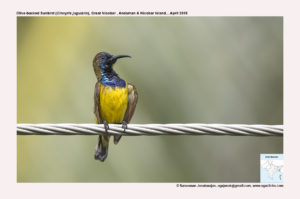Olive-backed Sunbird

Olive-backed Sunbird Cinnyris jugularis
Etymology:
- Cinnyris : Greek word kinnurissmall bird mentioned by Hesychius
- Jugularis : Latin word for Throated
Vernacular Names:Nicobar: Raycha
Distribution in India: Resident of North East and Andaman Islands in India.
Description: Size of 10–11·4 cm; male wt. is 6·7–11·9 g, female wt. is 6–10 g .The male of nominate race is olive above, with black remiges edged green, black tail tipped and edged white; blackish with iridescence on lores, side of neck, chin, throat and breast. It has yellow pectoral tufts; dark yellow below, occasionally with brown breastband bordering gorget; iris is dark brown; bill and legs are black. The non-breeding male has glossy black confined to medial throat stripe. The female is greenish-olive above, with pale yellowish supercilium, yellowish edges on wing feathers, white-tipped black tail, and deep yellow below, slightly paler on undertail-coverts; bare parts as male. The juvenile resembles female, but usually paler and browner. For the raceandamanicus male is browner above than preceding races, lacks metallic colour on forehead, has blue-green tinge in metallic colour of breast, a rusty breastband, bright yellow pectoral tufts , female is paler and duller. It is found in Andaman Islands. The race proselius has much brighter green upperparts and less bright underparts than last, centre of throat metallic purple, forecrown usually metallic purple-blue, throat and breast metallic purple-blue ,little or no maroon or chestnut on breast, rich yellow belly, pectoral tufts more orange.
Habitat: It is found in Nicobar Islands. It is found in forest types, including mangroves, at forest edge, in open country, scrub, coastal vegetation, agricultural land, plantations, parks and gardens; found in urban areas, as well as in rural ones. It is found from lowlands up to 1700 m.
Food habits: It eats Insects, spiders, nectar and small fruits. It forages singly, in pairs and in small groups; joins mixed-species flocks. It feeds at low levels. It hover-gleans for insects, and takes spiders while hovering in front of webs. It nectar-robs flowers.
Breeding habits: They breed in all months except Oct and Dec in Borneo and Java, and in all months in Australia; in Jan–Aug and Oct in Andaman and Jan and Mar in Nicobar, in Jan–Mar, Jun–Sept and Nov in Myanmar, Jan–May, Jul–Sept and Nov–Dec in Thailand, Dec–Jul in Malay Peninsula; May and Jun in Philippines and Jan and Feb in Sulawesi. They are multi-brooded. The nest isbuilt entirely by female. The nest is a pendulous oval purse, with hooded side entrance, usually with dangling “beard”, constructed from grass, cotton, bark, cocoons, moss, lichens, leaf fragments, vegetable fibers and spider webs, lined with bark or feathers, above ground, may be placed in spiny bush or suspended from palm frond, creepers, cable or fence wire, or roof or other part of house. They lay a clutch of 1–3 eggs. The incubation is done by female. The incubation period is 11–16 days. Thechicks aretended by both parents. The nestling period is 13–16 days. Nests are parasitized little Bronze-cuckoo. The nest predators include monitor lizards, rats and ground squirrels.